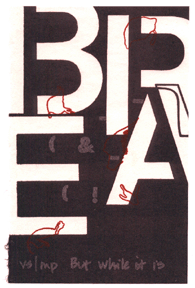
Where the Visual Meets the Verbal
Robert Miltner
continued . . .
![]()
Poets and Painters: Collaborators of the Modernist Period

Modernist poetry has a history of poets working in various relationships with
painters and other visual artists. J. D. McClatchy goes so far at to suggest that
modern poetry was invented by painters (xi). Using Pound's Imagist manifesto
as a means of foregrounding the visual among the verbal dimension of poetry,
he establishes the connection between modernism's visual artists and poets by
quoting William Carlos Williams: "No one knew consistently enough to
formulate a 'movement'. . . . We were restless and constrained, closely allied to
the painters. Impressionism, dadaism, surrealism applied to both painting and
the poem" (quoted in McClatchy xii). Williams, who considered the materiality
of language, was led to study both the paintings of Juan Gris and Gris'
writings ("On the Possibilities of Painting") on what the cubist painter referred
to as the architecture of construction which includes both the abstract and the
concrete (Sayre 8-9); Williams reduced this architectural concept in his own
poetry to the tensions existing between the abstractions of the human mind and
the concrete dimensions of the real world. Unable to fully synthesize the two,
Williams brought them into play in his poetry, discovering that at best, his
poetry produced "a record of the conversation between them, statement and
counterstatement, question and response" (Sayre 9). Thus, having seen Gris'
paintings (images) and read Gris' text (words) about the visual arts (images),
Williams discovers that the words and images in his own poems engage in a
dialogue which is divergent and dynamic, translating and transgressing. This
activity, however, observes Henry M. Sayre in The Visual Text of William
Carlos Williams, is not merely a copy or imitation of the visual arts, for
"Williams's 'translation' from painting to poem is not an exercise in repetition
but a project in re-vision; it is not a description, but a re-creation" (135), which
suggests the divergent nature of Williams' conversation with art.
We were restless and constrained, closely allied to
the painters. Impressionism, dadaism, surrealism applied to both painting and
the poem" (quoted in McClatchy xii). Williams, who considered the materiality
of language, was led to study both the paintings of Juan Gris and Gris'
writings ("On the Possibilities of Painting") on what the cubist painter referred
to as the architecture of construction which includes both the abstract and the
concrete (Sayre 8-9); Williams reduced this architectural concept in his own
poetry to the tensions existing between the abstractions of the human mind and
the concrete dimensions of the real world. Unable to fully synthesize the two,
Williams brought them into play in his poetry, discovering that at best, his
poetry produced "a record of the conversation between them, statement and
counterstatement, question and response" (Sayre 9). Thus, having seen Gris'
paintings (images) and read Gris' text (words) about the visual arts (images),
Williams discovers that the words and images in his own poems engage in a
dialogue which is divergent and dynamic, translating and transgressing. This
activity, however, observes Henry M. Sayre in The Visual Text of William
Carlos Williams, is not merely a copy or imitation of the visual arts, for
"Williams's 'translation' from painting to poem is not an exercise in repetition
but a project in re-vision; it is not a description, but a re-creation" (135), which
suggests the divergent nature of Williams' conversation with art.
Like Williams, Wallace Stevens turned to the visual arts as a means of accessing a way to enlarge the discussion both on poetry and on the arts in general. Considering the idea that there might be "a fundamental aesthetic of which poetry and painting are related but dissimilar manifestations," Stevens labeled such a connection as "speculative" (111); he goes on, however, to explain the "truth" that
. . . there seems to exist a corpus of remarks in respect to painting, most often the remarks of painters themselves, which are as significant to poets as to painters. All of these details, to the extent that they have the meaning for poets as well as for painters, are specific instances of relations between poetry and painting. (111)
These "relations" between poetry and painting were considered as well by Ezra Pound, whose influence on Modernism is extensive. If the language shared in ekphrastic collaboration is rooted in the visual image of the artist, then it is accessed, transgressed by the writer. For Pound, the image was at the heart of transgression, of border crossing, for the image was "more than an idea" ("Affirmations" 375). While the image could be anything from "a sketch, a vignette, a criticism, an epigram" to any aspect of "Impressionism," ultimately the image was "a vortex or cluster of fused ideas" ("Affirmations" 375), with vorticism having its interest "in the creative faculty as opposed to the mimetic" ("Vorticism" 16). Pound's consideration of fused ideas is interesting, for it suggests that the image itself is a fusion or collage of disparate parts, selected from the vortex, though it also suggests that the image creates a fusion between the giver of the image (the painter, the visual artist) and the receiver of the image (the writer), bonding the two through a shared dialogue.
|
Copyright © Enculturation 2001 |